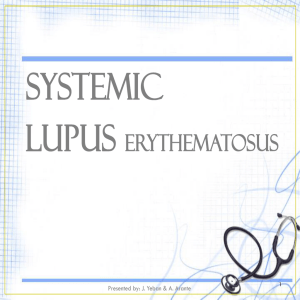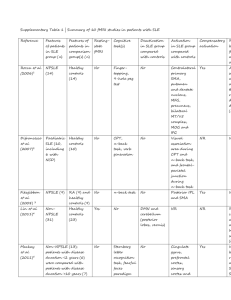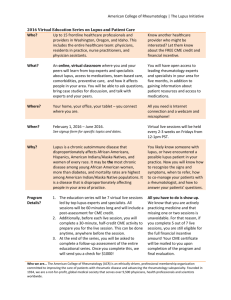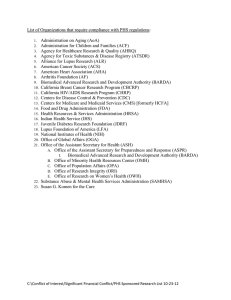by BS, Microbiology, Ohio State University, 2012
advertisement
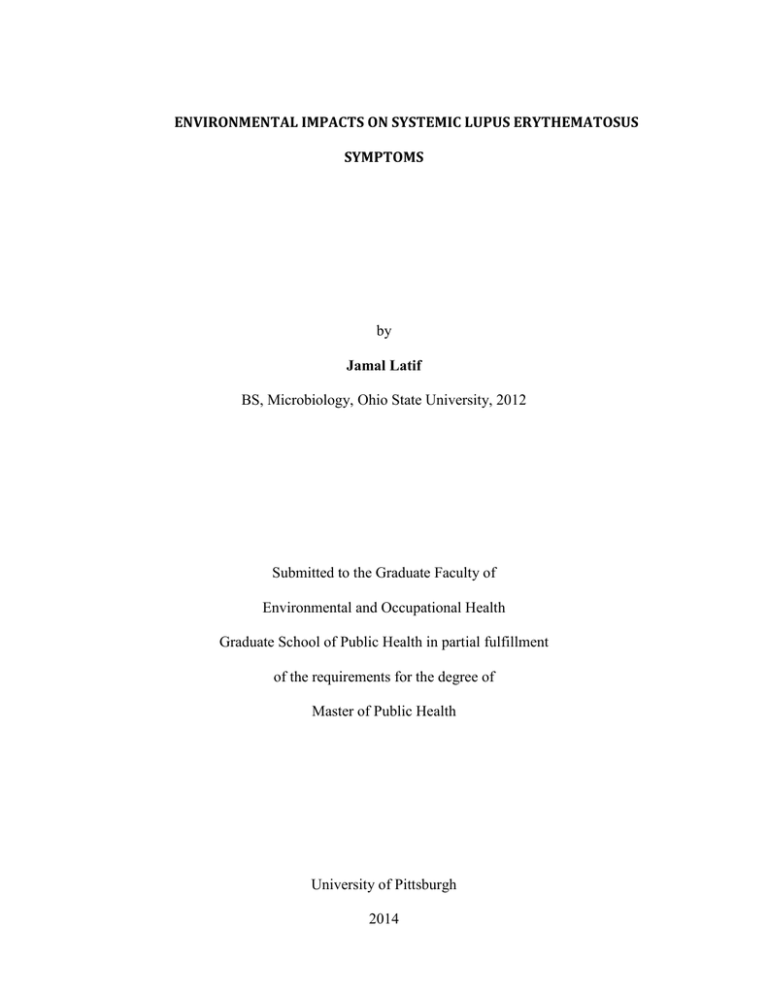
ENVIRONMENTAL IMPACTS ON SYSTEMIC LUPUS ERYTHEMATOSUS SYMPTOMS by Jamal Latif BS, Microbiology, Ohio State University, 2012 Submitted to the Graduate Faculty of Environmental and Occupational Health Graduate School of Public Health in partial fulfillment of the requirements for the degree of Master of Public Health University of Pittsburgh 2014 i UNIVERSITY OF PITTSBURGH GRADUATE SCHOOL OF PUBLIC HEALTH This essay is submitted by Jamal Latif on April 21, 2014 and approved by Essay Reader: Martha Ann Terry, PhD Assistant Professor and Director MPH Program Behavioral and Community Health Sciences Graduate School of Public Health University of Pittsburgh Essay Advisor: Luis A. Ortiz, MD Associate Professor Director, Division of Occupational Medicine Graduate School of Public Health University of Pittsburgh _________________________________ _________________________________ ii Copyright © by Jamal Latif 2014 iii Luis Ortiz, MD ENVIRONMENTAL IMPACTS ON SYSTEMIC LUPUS ERYTHEMATOSUS SYMPTOMS Jamal Latif, MPH University of Pittsburgh, 2014 ABSTRACT Systemic Lupus Erythematosus (SLE) is a chronic autoimmune disease that affects about 16,000 people a year and is a major public health concern within the United States and around the world. Lupus has gone under the radar for too long, being mistakenly diagnosed as many other diseases because of the spectrum of symptoms that can occur. Many different antagonists can cause these symptoms, but researchers over the past decade have found that many triggers in our environment are linked to Lupus symptom flare-ups. This essay describes the symptoms and causes of Lupus as a way to better understand the direct connection between the environment and components on the disease. iv TABLE OF CONTENTS PREFACE ................................................................................................................................. VIII 1.0 INTRODUCTION ........................................................................................................ 1 2.0 REVIEW ....................................................................................................................... 2 2.1 SYMPTOMS ........................................................................................................ 2 2.2 ENVIRONMENTAL LINKS ............................................................................. 5 3.0 4.0 2.2.1 Sun exposure .................................................................................................... 5 2.2.2 Environmental Estrogens................................................................................ 5 2.2.3 Hair Dyes .......................................................................................................... 6 2.2.4 Infections .......................................................................................................... 7 GRAPHICAL OVERVIEW........................................................................................ 8 3.1 INCIDENCE OF SLE ......................................................................................... 8 3.2 SUN EXPOSURE................................................................................................. 9 3.3 ENVIRONMENTAL ESTROGENS ............................................................... 10 3.4 HAIR DYES ....................................................................................................... 11 3.5 INFECTIONS .................................................................................................... 12 CONCLUDING REMARKS .................................................................................... 14 BIBLIOGRAPHY ....................................................................................................................... 15 v LIST OF TABLES Table 1. Incidence of SLE .............................................................................................................. 8 Table 2. Sun Exposure .................................................................................................................... 9 Table 3. Environmental Estrogens ................................................................................................ 10 Table 4. Hair Dyes ........................................................................................................................ 11 Table 5. Infections ........................................................................................................................ 12 vi LIST OF FIGURES Figure 1. Summary of Environmental Triggers .............................................................................. 4 vii PREFACE Dear Mom, I wanted to let you about the condition that you have been going through and how much it has affected me as a son and a scholar. I wrote this essay for you in order to educate myself and hopefully other people and families going through a similar situation. viii 1.0 INTRODUCTION What if a terrorist organization developed a virus to attack the United States and successfully infected 1.5 million citizens? What if they used that same virus to infect another 3.5 million people worldwide? There would be outrage and researchers trying to solve this issue. There is a currently a condition in the United States and worldwide that affect five million people which goes virtually unnoticed (Sarzi-Puttini et al., 2005) System Lupus Erythematosus (Lupus) is this condition that has gone under the radar for too long, mistakenly diagnosed as many other diseases because of the wide range of symptoms that can occur. Many different antagonists can trigger these symptoms, but researchers over the past decade have found that there are many environmental causes at the root of Lupus symptom flare-ups. This essay can serve as a guide on the relevant research that has been occurring in this realm of environmental public health research with the goal of helping those who suffer from Lupus 1 2.0 2.1 REVIEW SYMPTOMS Lupus causes pain and confuses the natural machinery that typically runs the body. Researchers have yet to find a definitive cause or cure for this condition. There are many ideas about what causes SLE, and researchers are working on treatments for the different symptoms (Zandman-Goddard et al., 2012) They are hopeful that a cure will be developed for future generations, but for now the approach is to treat individual symptoms . Although somewhat hard to predict, SLE seems to mainly affect the heart, joints, skin, lungs, blood vessels, liver, kidneys, and nervous system. In some cases people may have been diagnosed with rheumatoid arthritis (RA) before the doctor ever realized they had Lupus. RA is one of the common symptoms, since the immune system begins to target joints (Sarzi-Puttini et al., 2005) The product of these attacks mimics those in patients who have only rheumatoid arthritis. There may also be other symptoms, such as inflammation in the hands and legs. At checkups the doctor may conduct assessment tests in order to determine how the liver and kidneys are functioning. These tests are necessary because the more the your immune system attacks itself, the more the liver and kidneys have to work in order to filter out the waste that is left behind by the immune attacks (Rudofsky and Lawrence, 1999). This creates a backup in the 2 filtration system in the kidneys, causing another symptom called Lupus nephritis (Mortensen, Fenton and Rekvig, 2008) Nephritis means this form of Lupus affects the kidneys. This backup creates a surplus of fluids in the body, which ultimately settles in the extremities, causing a condition edema (Mortensen, Fenton and Rekvig, 2008). Sometimes people have trouble reading, they may notice that you’re their vision has become less crisp than before. As individuals grow older, weakening of vision is due to the central nervous system impacts that Lupus is known to cause. Blood vessel changes to the inner light sensitive part of the eye, also known as the retina, cause difficulty in seeing (Yen et al., 2013). Doctors refer to these changes as retinal vascular lesions. These lesions or micro-tears are due to the lack of adequate blood supply to this delicate tissue (Yen et al., 2013). Another symptom common to Lupus sufferers experience is the malar rash, also known as a butterfly rash that may occur on the face. This rash is nicknamed a butterfly rash because of the location on the face starting from one cheek going across the bridge of the nose onto the other cheek, resembling the general shape of a butterfly (D'Cruz, Khamashta and Hughes, 2007). This rash is painful and does not have the most pleasant appearance; but there are things that individuals can avoid in the environment to reduce the chance of this symptom, along with many of the others. It is useful to look at the environmental context of these. There are different antagonists that individuals can try to avoid in order to reduce symptoms, not leaving everything up to the variety of medicines that may be prescribed. People who are genetically predisposed to Lupus need to take extra care with the environmental contacts they make on a daily basis. The mechanisms by which these environmental exposures interact with the disease are not clearly understood. What we do know is that exposures to infectious agents, chemicals, pollutants, and 3 drugs, and behavioral factors such as smoking and diet can have a major impact on the expression of Lupus symptoms. (Jonsen et al., 2007). Below is a general flow chart showing different environmental triggers and the path towards eventual tissue injury and damage. A discussion of some of the main environmental triggers follows, with explanations of how they lead to painful symptoms that some experience. (Sarzi-Puttini et al., 2005) Figure 1. Summary of Environmental Triggers 4 2.2 ENVIRONMENTAL LINKS 2.2.1 Sun exposure One of the biggest environmental impacts that has been linked to SLE development and flare-ups, is ultraviolet light. In essence, UV light from the sun can impact processes in the human body, which has impacts on everyone. But, this UV exposure has an especially negative result on people who are genetically prone to SLE. The genes that create the enzyme glutathionS-transferase are targeted by sun exposure, resulting in an increased risk of SLE development (Jonsen et al., 2007). Glutathion-S-transferase is used in the detoxification processes in the body, specifically targeting the reduced form of glutathione and turning it into xenobiotic substrates (Jonsen et al.) This is important, because when this process is disrupted, the immune system is triggered in order to try to quell this issue. SLE is an autoimmune disease, so when the immune system is being hyperactive, individuals will experience a lot of those painful symptoms noted above. 2.2.2 Environmental Estrogens Synthetic estrogens are found in increasing amounts in people today more than in the past. This is due to many contributing factors, but one of the contributors of synthetic estrogen is the consumption of meat and milk products from livestock fed synthetic estrogens (Strohsnitter et al., 2010). The practice of introducing growth-promoting hormones into livestock animals 5 began in the 1960s by decree of the Food and Drug Administration (FDA), because of its revolutionary ability to produce more meat with much less feed. Studies have shown a potential link between autoimmune disorders and prenatal diethylstilbestrol (a synthetic estrogen) (Strohsnitter et al., 2010). Although this is a major way these hormones are introduced into the body, an even bigger route of exposure is regular oral contraception use. This flood of synthetic estrogen has been shown to induce or reveal the existence of SLE (Bernier et al., 2009). But as with most studies on the subject of SLE, there are major studies that also find opposite results. One is a study of 183 women with stable systemic lupus erythematosus. They were randomly assigned to receive either oral contraceptives or a placebo and were observed for a 12-month period (Bernier et al., 2009). At the end of the 12 month period, the same number of women in both groups had severe flare-ups. This shows that there was not an increase in flare-ups due to the women having increased hormone levels because of the intake of synthetic estrogen by way of oral contraceptive. 2.2.3 Hair Dyes Another antagonist that is not as prevalent, but is one that many women have encountered is hair dyes. They contain chemical compounds called arylamines. While the evidence is not completely conclusive, some have linked hair dyes to diseases such as bladder cancer and case SLE (Jimenez-Alonso et al., 2002). The reason is thought to be that they are not metabolized like many other toxins that enter our bodies. This seems to be related to the fact that N-actyl transferase, the enzyme in charge of metabolizing arylamines, is dramatically slowed down with the surge of this toxin found in hair dyes (Jimenez-Alonso et al., 2002). 6 2.2.4 Infections Since SLE is an autoimmune disorder, viral and bacterial infections are common, and remain a significant source of morbidity. Viruses such as Epstein-Barr virus (EBV) have also been identified as a possible factor in the development of lupus. This virus can reside in and interact with B cells (immune receptors that recognize antigens and create antibodies in order to protect the body against them) (D'Cruz, Khamashta and Hughes, 2007). The corruption of B cells is important, because the immune system is already overactive, allowing many B cells in the system vulnerable to attacks. EBV is not the only virus that is circulated in the environment that can cause a negative reaction for Lupus. There are many others, including many bacterial diseases that are able to replicate the impact that viruses do. Again this is due to the fact that the immune system is severely overactive. 7 3.0 GRAPHICAL OVERVIEW This section presents numbers behind the different issues presented above. Table 1 shows the incidence of systemic lupus erythematosus in the United States alone. 3.1 INCIDENCE OF SLE Table 1. Incidence of SLE (Furst et al., 2013) 8 This study observed the incidence of lupus in people from 2003-2008, per 100,000 patients they received. They have a crude rate for every year of the study, which is the number of patients they found to have lupus, no matter what age they were at the time of diagnosis. The second column presents age and gender adjusted rate. The reason for this number is for the researchers to see if SLE targets people in a certain age range. Also, it is believed that women are much more likely than men to be diagnosed with SLE, so this second adjustment was made in order to reaffirm this point. As can be seen, women are much more likely to be diagnosed with lupus with a rate of 11.89 per 100,000 compared to that of men, who have an incidence of 2.21 per 100,000. Women 45+ are much more likely to have lupus than their younger peers. Over the span of the research, the incidence rate of SLE has been steady. 3.2 SUN EXPOSURE Table 2. Sun Exposure (Jonsen et al., 2007). 9 As noted above, sun exposures can induce flare-ups. This has been supported by different studies, one of which collected the data in Table 2, which compares patients with different types of Lupus, (SLE, systemic lupus erythematosus; CDLE, chronic cutaneous discoid lupus erythematosus; SCLE, subacute lupus erythematosus) to a control group of healthy patients. Lupus patients were tested for photosensitivity, and 14 out of 30 patients (46.7%) had a photosensitive reaction, with six of those patients diagnosed with SLE. This study is so important because photosensitivity is a major criterion of the American College of Rheumatology for the diagnosis of this very disease. Understanding this environmental factor will help improve individuals’ ability to manage their disease. 3.3 ENVIRONMENTAL ESTROGENS Table 3. Environmental Estrogens (Mok and Lau, 2003). 10 The table above summarizes how environmental estrogens can have an impact on various cell types within the body’s immune system. Physiological estrogens (created within the body) typically facilitate a humoral response, leading to an increase of B cell and IL-2 production (Mok and Lau). Both of these are cells are important in the functionality of the immune system. Estrogens that enter the body from the environment have an opposite effect, which reacts in the opposite direction when there are high doses, inhibiting IL-2 production as well as T cells (Mok and Lau, 2003). The important thing is to recognize that these compounds can have an ill effect, because it appears that these effects are unique to patients with SLE. This tells us that lupus T cells are more sensitive to oestrogens and that they should be avoided in order to reduce aggravating the immune system any further. 3.4 HAIR DYES Table 4. Hair Dyes (Hardy et al., 1999) There have been few studies to research the possible correlation between hair dyes and the effect they have on SLE. One of these had a small group of 74 patients, and found that their hair product usage was not statistically significant compared to the control group when it came to SLE incidence (Hardy et al. 1999). Another study with even fewer patients (44) found a positive 11 association between the development of disease and hair dye use (Balluz et al., 2001). But, since both studies analyzed such small groups, it is hard to tell whether this is an issue for those who suffer from SLE. A third study observed 150 patients on their use of each of the five hair dying techniques listed above in Table 4. Although 150 patients is still a small group when it comes to statistical analysis, these researchers found no link between any of these hair treatments and the development or flare-up of SLE (Hardy et al., 1999). This is an example of how many different things can be presumably linked to a disease, without any peer-reviewed research to back the assumptions. 3.5 INFECTIONS Table 5. Infections (Iuliano et al., 2012) Earlier it was noted that Lupus patients are targets for viral and bacterial infections. These infections are typically dealt with by a strong healthy immune system. For those with 12 Lupus, the issue lies within the immune system and the overactive and dysfunctional nature of it. In Table 5., are examples of different microorganisms and their frequency of total infections. Basically this is a list of common bacterial, fungal, and viral which can play a major negative role in overall health with SLE in various ways. The most major is the fact that SLE may mimic symptoms such as fevers and inflammatory syndromes that happen to be symptoms of the microorganisms listed (Iuliano et al., 2012). The issue with this is that it makes it difficult for a physician to realize the symptoms are from an alternative source other than SLE. This allows for opportunistic infections that greatly exacerbate the condition. Patients can contribute to their own disease management by keeping track of their symptoms and when they occur. 13 4.0 CONCLUDING REMARKS There are many things in the environment that can exacerbate SLE. Those with Lupus should not live in fear of their surroundings, but that SLE should be seen as an alternative lifestyle to live with. With this way of thinking the new medicines, diet, and other changes may be less of a burden. By understanding the way the different irritants and toxicants interact with the body, the better patients will be able to maintain a healthy lifestyle. There are a lot of uncertainties when it comes to SLE research. This is because of the lack of funding Lupus research has when compared to other more, “mainstream” diseases such as breast cancer and AIDS. With only one non-profit solely dedicated to Lupus research (Lupus Research Institute), only $30 million dollars in its 14 years of existence has been allocated for novel research grants. This may seem like a lot, but when compared to the estimated $6 billion that breast cancer research raises every single year, it is unacceptably low. In order to further improve the quality of life for patients with Lupus, more money must be made available to be used for novel research. Without readily available funds, highly qualified researchers who may have an interest in Lupus research may tackle other pursuits. On a positive note, there is a steady increase in the awareness and funding for this disease. This gives hope that the environmental impacts on SLE will be studied thoroughly allowing people to live longer and healthier live. 14 BIBLIOGRAPHY Balluz, L., et al. "Investigation of Systemic Lupus Erythematosus in Nogales, Arizona." Am J Epidemiol 154.11 (2001): 1029-36. Print. Bernier, M. O., et al. "Combined Oral Contraceptive Use and the Risk of Systemic Lupus Erythematosus." Arthritis Rheum 61.4 (2009): 476-81. Print. D'Cruz, D. P., M. A. Khamashta, and G. R. Hughes. "Systemic Lupus Erythematosus." Lancet 369.9561 (2007): 587-96. Print. Furst, D. E., et al. "Incidence and Prevalence of Adult Systemic Lupus Erythematosus in a Large Us Managed-Care Population." Lupus 22.1 (2013): 99-105. Print. Hardy, C. J., et al. "Systemic Lupus Erythematosus (Sle) and Hair Treatment: A Large Community Based Case-Control Study." Lupus 8.7 (1999): 541-4. Print. Iuliano, Annamaria, et al. "Opportunistic Infections in Systemic Lupus Erythematosus." International Journal of Clinical Rheumatology 7 (2012): 275+. Print. Jimenez-Alonso, J., et al. "Hair Dye Treatment Use and Clinical Course in Patients with Systemic Lupus Erythematosus and Cutaneous Lupus." Lupus 11.7 (2002): 430-4. Print. Jonsen, A., et al. "Gene-Environment Interactions in the Aetiology of Systemic Lupus Erythematosus." Autoimmunity 40.8 (2007): 613-7. Print. Mok, C. C., and C. S. Lau. "Pathogenesis of Systemic Lupus Erythematosus." J Clin Pathol 56.7 (2003): 481-90. Print. Mortensen, E. S., K. A. Fenton, and O. P. Rekvig. "Lupus Nephritis: The Central Role of Nucleosomes Revealed." Am J Pathol 172.2 (2008): 275-83. Print. Rahman, Anisur, and David A. Isenberg. "Systemic Lupus Erythematosus." New England Journal of Medicine 358.9 (2008): 929-39. Print. Rudofsky, U. H., and D. A. Lawrence. "New Zealand Mixed Mice: A Genetic Systemic Lupus Erythematosus Model for Assessing Environmental Effects." Environ Health Perspect 107 Suppl 5 (1999): 713-21. Print. Sarzi-Puttini, P., et al. "Environment and Systemic Lupus Erythematosus: An Overview." Autoimmunity 38.7 (2005): 465-72. Print. Strohsnitter, W. C., et al. "Autoimmune Disease Incidence among Women Prenatally Exposed to Diethylstilbestrol." J Rheumatol 37.10 (2010): 2167-73. Print. Yen, Y. C., et al. "Risk of Retinal Vein Occlusion in Patients with Systemic Lupus Erythematosus: A Population-Based Cohort Study." Br J Ophthalmol 97.9 (2013): 11926. Print. Zandman-Goddard, G., et al. "Environment and Lupus-Related Diseases." Lupus 21.3 (2012): 241-50. Print. 15
